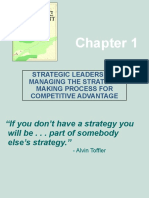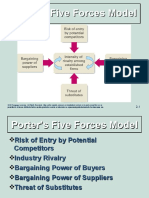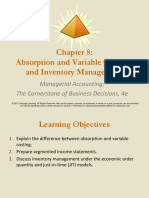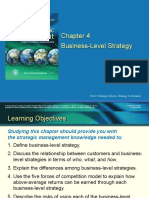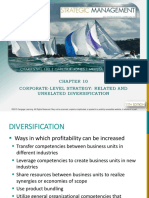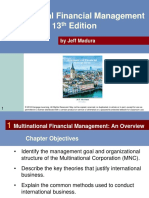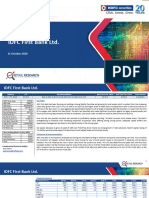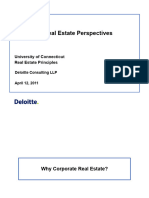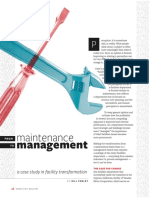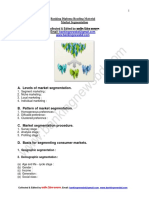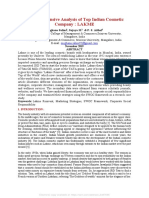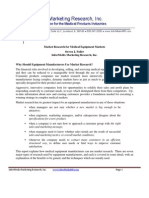Strategic Management - Business Level Strategies
Strategic Management - Business Level Strategies
Uploaded by
Rohit GuptaCopyright:
Available Formats
Strategic Management - Business Level Strategies
Strategic Management - Business Level Strategies
Uploaded by
Rohit GuptaCopyright
Available Formats
Share this document
Did you find this document useful?
Is this content inappropriate?
Copyright:
Available Formats
Strategic Management - Business Level Strategies
Strategic Management - Business Level Strategies
Uploaded by
Rohit GuptaCopyright:
Available Formats
BUILDING COMPETITIVE
ADVANTAGE THROUGH
BUSINESS-LEVEL STRATEGY
Learning Objectives
• Explain why company must define business
and how managers does this
• Define competitive positioning, explain
tradeoffs between differentiation, cost and
pricing
• Identify choices managers make to pursue
business model
• Explain why each business model allows
company to outperform rivals
• Discuss why some can successfully make
the competitive positioning decisions
2010 Cengage Learning. All Rights Reserved. May not be copied, scanned, or duplicated, in whole or in part, except for use as
permitted in a license distributed with a certain product or service or otherwise on a password-protected website for classroom use. 5-2
Business-Level Strategy
A successful business model results from
business-level strategies that create a
competitive advantage over its rivals.
Firms must decide/evaluate:
1. Customer needs–
WHAT is to be satisfied
2. Customer groups–
WHO is to be satisfied
3. Distinctive competencies–
HOW customers are to be
satisfied
2010 Cengage Learning. All Rights Reserved. May not be copied, scanned, or duplicated, in whole or in part, except for use as
permitted in a license distributed with a certain product or service or otherwise on a password-protected website for classroom use. 5 -3
Customer Needs and
Product Differentiation
o Customer needs- desires, wants, or
cravings to be satisfied through
product attributes
Customers choose product based on:
1. Way product differentiated from others
2. Price of product
o Product differentiation- designing
products to satisfy customers’ needs in
ways competing products cannot
2010 Cengage Learning. All Rights Reserved. May not be copied, scanned, or duplicated, in whole or in part, except for use as
permitted in a license distributed with a certain product or service or otherwise on a password-protected website for classroom use. 5-4
Customer Groups
and Market Segmentation
o Market Segmentation- customers grouped
based on differences in needs or preferences
o Main Approaches to Segmenting Markets
1. Ignore differences in segments– make product for
typical/average customer
2. Recognize differences between segments– make
products that meet needs of all/most segments
3. Target specific segments– focus on/serve one or
two selected segments
2010 Cengage Learning. All Rights Reserved. May not be copied, scanned, or duplicated, in whole or in part, except for use as
permitted in a license distributed with a certain product or service or otherwise on a password-protected website for classroom use. 5-5
Identifying Customer
Groups and Market Segments
Figure 5.1
2010 Cengage Learning. All Rights Reserved. May not be copied, scanned, or duplicated, in whole or in part, except for use as
permitted in a license distributed with a certain product or service or otherwise on a password-protected website for classroom use. 5-6
Three Approaches
to Market Segmentation
Figure 5.2
2010 Cengage Learning. All Rights Reserved. May not be copied, scanned, or duplicated, in whole or in part, except for use as
permitted in a license distributed with a certain product or service or otherwise on a password-protected website for classroom use. 5-7
Implementing
the Business Model
Strategic managers must devise strategies
that determine how:
• To DIFFERENTIATE & PRICE product
• To SEGMENT market & how
WIDE A RANGE of products to develop
A profitable business model
depends on providing customer with most
value while keeping cost structures viable.
2010 Cengage Learning. All Rights Reserved. May not be copied, scanned, or duplicated, in whole or in part, except for use as
permitted in a license distributed with a certain product or service or otherwise on a password-protected website for classroom use. 5-8
Competitive Positioning
at the Business Level
Maximizing profitability of the business model is making the right
choices on value creation through differentiation, costs, and pricing.
Figure 5.4
2010 Cengage Learning. All Rights Reserved. May not be copied, scanned, or duplicated, in whole or in part, except for use as
permitted in a license distributed with a certain product or service or otherwise on a password-protected website for classroom use. 5-11
Competitive Positioning and
the Value Creation Frontier
Figure 5.5
Value Creation Frontier
represents the maximum
value the products of
different companies inside
an industry can give
customers at any one time
by using different
business models.
Companies on the value
creation frontier have the
most successful strategy
in a particular industry.
2010 Cengage Learning. All Rights Reserved. May not be copied, scanned, or duplicated, in whole or in part, except for use as
permitted in a license distributed with a certain product or service or otherwise on a password-protected website for classroom use. 5 -12
Generic Business-Level Strategies
1. Cost Leadership- Lowest cost structure
vis-à-vis competitors allowing price
flexibility & higher profitability
2. Focused Cost Leadership- Cost
leadership in selected market niches where
it has a local or unique cost advantage
3. Differentiation - Features important to
customers & distinct from competitors that
allow premium pricing
4. Focused Differentiation-
Distinctiveness in selected market niches
where it better meets the needs of
customers than the broad differentiators
2010 Cengage Learning. All Rights Reserved. May not be copied, scanned, or duplicated, in whole or in part, except for use as
permitted in a license distributed with a certain product or service or otherwise on a password-protected website for classroom use. 5 -11
Generic Business Models and
the Value Creation Frontier
Figure 5.6
Four Principal
Generic Strategies
1. Cost Leadership
2. Focused
Cost Leadership
3. Differentiation
4. Focused
Differentiation
2010 Cengage Learning. All Rights Reserved. May not be copied, scanned, or duplicated, in whole or in part, except for use as
permitted in a license distributed with a certain product or service or otherwise on a password-protected website for classroom use. 5 -12
Cost Leadership
Establishes a cost structure that allows them
to provide goods/services at lower unit costs
Strategic Choices
• Cost leader does not try to be industry
innovator.
• Cost leader positions products to
appeal to “average” or typical
customer.
• Overriding goal of cost leader is to
increase efficiency & lower costs
relative to industry rivals.
2010 Cengage Learning. All Rights Reserved. May not be copied, scanned, or duplicated, in whole or in part, except for use as
permitted in a license distributed with a certain product or service or otherwise on a password-protected website for classroom use. 5 -13
Advantages of
Cost Leadership Strategies
o Protected from competitors by cost advantage
o Less affected by increased prices of
inputs if there are powerful suppliers
o Less affected by a fall in price of
inputs if there are powerful buyers
o Purchases in large quantities increase
bargaining power over suppliers
o Ability to reduce price to compete
with substitute products
o Low costs and prices are a barrier to entry
Cost leaders able to charge lower price or
achieve superior profitability at same price.
2010 Cengage Learning. All Rights Reserved. May not be copied, scanned, or duplicated, in whole or in part, except for use as
permitted in a license distributed with a certain product or service or otherwise on a password-protected website for classroom use. 5 -14
Disadvantages of
Cost Leadership Strategies
Competitors may lower
their cost structures.
Competitors may
imitate cost
leader’s methods.
Cost reductions
may affect demand.
2010 Cengage Learning. All Rights Reserved. May not be copied, scanned, or duplicated, in whole or in part, except for use as
permitted in a license distributed with a certain product or service or otherwise on a password-protected website for classroom use. 5-15
Differentiation
Companies with differentiation
strategy create product different or distinct
from competitors in important way.
Strategic Choices- Differentiator
» Strives to differentiate itself on as many
dimensions as possible.
» Focuses on quality, innovation, and
responsiveness to customer needs.
» May segment market in many niches.
» Concentrates on organizational functions
that provide source of distinct advantages .
2010 Cengage Learning. All Rights Reserved. May not be copied, scanned, or duplicated, in whole or in part, except for use as
permitted in a license distributed with a certain product or service or otherwise on a password-protected website for classroom use. 5-16
Advantages of
Differentiation Strategies
o Customers develop brand loyalty.
o Powerful suppliers not problem because company
geared more toward price it can charge than costs.
o Can pass price increases on to loyal customers.
o Powerful buyers not problem because product
distinct.
o Differentiation & brand loyalty = barriers to entry.
o Threat of substitute products depends on
competitors’ ability to meet customer needs.
Differentiators create demand for their
distinct products and charge a premium price,
resulting in greater revenue and higher profitability.
2010 Cengage Learning. All Rights Reserved. May not be copied, scanned, or duplicated, in whole or in part, except for use as
permitted in a license distributed with a certain product or service or otherwise on a password-protected website for classroom use. 5-17
Disadvantages of
Differentiation Strategies
o Difficulty maintaining long-term
distinctiveness in customers’ eyes.
• Agile competitors can quickly imitate.
• Patents and first-mover advantage
are limited in duration.
o Difficulty maintaining premium
price.
2010 Cengage Learning. All Rights Reserved. May not be copied, scanned, or duplicated, in whole or in part, except for use as
permitted in a license distributed with a certain product or service or otherwise on a password-protected website for classroom use. 5 -18
Focus
Focuser strives to serve need of targeted
niche market segment where it has either low-
cost or differentiated competitive advantage.
Strategic Choices- Focus
• Focuser selects specific market based on:
Geography
Type of customer
Segment of product line
• Focused company positions self as either:
Low-Cost or
Differentiator
2010 Cengage Learning. All Rights Reserved. May not be copied, scanned, or duplicated, in whole or in part, except for use as
permitted in a license distributed with a certain product or service or otherwise on a password-protected website for classroom use. 5 -19
Advantages of
Focus Strategies
o Focuser protected from rivals to extent can
provide a product /service they cannot.
o Focuser has power over buyers because
they cannot get same thing elsewhere
o Threat of new entrants limited by customer
loyalty to focuser.
o Customer loyalty lessens threat from
substitutes.
o Focuser stays close to customers and
changing needs.
2010 Cengage Learning. All Rights Reserved. May not be copied, scanned, or duplicated, in whole or in part, except for use as
permitted in a license distributed with a certain product or service or otherwise on a password-protected website for classroom use. 5-20
Disadvantages of
Focus Strategies
o Focuser at disadvantage to powerful
suppliers because it buys in small volume
(but may pass costs to loyal customers).
o Because of low volume, focuser may have
higher costs than low-cost company.
o Focuser’s niche may disappear because of
technological change or changes in
customers’ tastes.
o Differentiators will compete for focuser’s
niche.
2010 Cengage Learning. All Rights Reserved. May not be copied, scanned, or duplicated, in whole or in part, except for use as
permitted in a license distributed with a certain product or service or otherwise on a password-protected website for classroom use. 5 -21
Why Focus Strategies
Are Different
Figure 5.7
2010 Cengage Learning. All Rights Reserved. May not be copied, scanned, or duplicated, in whole or in part, except for use as
permitted in a license distributed with a certain product or service or otherwise on a password-protected website for classroom use. 5 -22
Competitive Positioning:
Strategic Groups
Groups of companies follow
a business model similar to other
companies within their strategic group, but are
different from other companies in other groups.
Strategic managers must:
1. Map their competitors
2. Better understand changes in industry
3. Determine which strategies are successful
4. Fine tune or radically alter business models
& strategies to improve competitive position
2010 Cengage Learning. All Rights Reserved. May not be copied, scanned, or duplicated, in whole or in part, except for use as
5-23
permitted in a license distributed with a certain product or service or otherwise on a password-protected website for classroom use.
Failures in
Competitive Positioning
o Many companies:
• Do not work continually to improve business model
• Do not perform strategic group analysis
• Often fail to identify/respond to changing
opportunities/threats in industry environment
o Companies lose position on value frontier
when:
• Lost source of competitive advantage
• Rivals find ways to push out value creation frontier
and leave them behind
There is no more important task than
ensuring company is optimally positioned
against its rivals to compete for customers.
2010 Cengage Learning. All Rights Reserved. May not be copied, scanned, or duplicated, in whole or in part, except for use as
permitted in a license distributed with a certain product or service or otherwise on a password-protected website for classroom use. 5-24
“We know what happens to
people who stay in the middle
of the road. They get run over.”
- Aneurin Bevan
2010 Cengage Learning. All Rights Reserved. May not be copied, scanned, or duplicated, in whole or in part, except for use as
© RoyaltyFree/PhotoLink/
permitted in a license distributed with a certain product or service or otherwise on a password-protected Getty
website for classroom use. Images 5 | 25
You might also like
- Hitt PPT 12e ch08-SMDocument32 pagesHitt PPT 12e ch08-SMHananie NanieNo ratings yet
- Summary Book Principles of Marketing Chapters 1 12Document58 pagesSummary Book Principles of Marketing Chapters 1 12Aira Evangelista100% (1)
- Chapter 9 Corporate Level StrategyDocument21 pagesChapter 9 Corporate Level Strategyabrar171No ratings yet
- Strategic Leadership: Managing The Strategy-Making Process For Competitive AdvantageDocument34 pagesStrategic Leadership: Managing The Strategy-Making Process For Competitive AdvantageRohith NNo ratings yet
- Hill 9e PPT Inst Ch06 BLS 2Document30 pagesHill 9e PPT Inst Ch06 BLS 2Suhas VNo ratings yet
- Lecture 5 - Business Level Stratey Read-OnlyDocument63 pagesLecture 5 - Business Level Stratey Read-OnlymichellebaileylindsaNo ratings yet
- Chap%208%20-%20International%20Strategy 2Document26 pagesChap%208%20-%20International%20Strategy 2Shaun LewNo ratings yet
- Week 3Document47 pagesWeek 3RainyNo ratings yet
- Porter's 5 ForcesDocument8 pagesPorter's 5 ForcesReefat AnwarNo ratings yet
- International Corporate Finance 11 Edition: by Jeff MaduraDocument34 pagesInternational Corporate Finance 11 Edition: by Jeff MaduraMahmoud SamyNo ratings yet
- Building Competitive Advantage Through Functional-Level StrategyDocument30 pagesBuilding Competitive Advantage Through Functional-Level StrategyRohith NNo ratings yet
- Developing Competitive Advantage and Strategic FocusDocument31 pagesDeveloping Competitive Advantage and Strategic FocusJimmy YeungNo ratings yet
- Chapter 10Document25 pagesChapter 10Ngoc Pham BichNo ratings yet
- Cost LeadershipDocument45 pagesCost Leadershipphillis zhaoNo ratings yet
- Strategic Management: Concepts and Cases 9eDocument33 pagesStrategic Management: Concepts and Cases 9eKamran AlviNo ratings yet
- Absorption and Variable Costing, and Inventory ManagementDocument46 pagesAbsorption and Variable Costing, and Inventory Managementtira sundayNo ratings yet
- Absorption and Variable Costing, and Inventory Management: Cornerstones of Managerial Accounting, 4eDocument46 pagesAbsorption and Variable Costing, and Inventory Management: Cornerstones of Managerial Accounting, 4eFahad Dahir AbukarNo ratings yet
- Charles W. L. Hill / Gareth R. JonesDocument25 pagesCharles W. L. Hill / Gareth R. JonesSamNo ratings yet
- Topic 1 - Chapter 1Document17 pagesTopic 1 - Chapter 1Bui Tra MyNo ratings yet
- ICF11e ch13Document28 pagesICF11e ch13Felicia AngelicaNo ratings yet
- Ch1 Hitt Lecture Strategic MGMT and Strategic CompetitivenessDocument73 pagesCh1 Hitt Lecture Strategic MGMT and Strategic CompetitivenessmichellebaileylindsaNo ratings yet
- Strategic Management An Integrated Approach 10th Edition Hill Solutions Manual 1Document16 pagesStrategic Management An Integrated Approach 10th Edition Hill Solutions Manual 1michael100% (67)
- W01. Ch01-PresentationDocument37 pagesW01. Ch01-Presentationtomec72872No ratings yet
- Chapter 16 Monopolistic CompetitionDocument24 pagesChapter 16 Monopolistic CompetitionThanh NguyenNo ratings yet
- BUS 444 - Chapter 4Document43 pagesBUS 444 - Chapter 4JY100% (1)
- Hitt PPT 12e ch04Document46 pagesHitt PPT 12e ch04RorNo ratings yet
- BUS 444 - Chapter 5Document33 pagesBUS 444 - Chapter 5JYNo ratings yet
- MA - 5e - PPT - CH 13 - SE SHORT RUN DECISION MAKING RELEVANT COSTINGDocument32 pagesMA - 5e - PPT - CH 13 - SE SHORT RUN DECISION MAKING RELEVANT COSTINGOksigeny GirlsNo ratings yet
- ch003 - TaggedDocument17 pagesch003 - Taggedrawanhussain4567No ratings yet
- Chapter4 180819015559Document28 pagesChapter4 180819015559abdifatahibro6515No ratings yet
- Internal Analysis: Distinctive Competencies, Competitive Advantage, and ProfitabilityDocument26 pagesInternal Analysis: Distinctive Competencies, Competitive Advantage, and ProfitabilityRohith NNo ratings yet
- Monopoly: Powerpoint Slides Prepared By: Andreea Chiritescu Eastern Illinois UniversityDocument58 pagesMonopoly: Powerpoint Slides Prepared By: Andreea Chiritescu Eastern Illinois UniversityDelmisVasquezMendozaNo ratings yet
- Activity-Based Costing and Management: Managerial Accounting: The Cornerstone of Business Decisions, 4eDocument60 pagesActivity-Based Costing and Management: Managerial Accounting: The Cornerstone of Business Decisions, 4etira sundayNo ratings yet
- External Analysis: The Identification of Opportunities and ThreatsDocument25 pagesExternal Analysis: The Identification of Opportunities and ThreatsMohit RajaiNo ratings yet
- Short Run Decision Making: Relevant CostingDocument47 pagesShort Run Decision Making: Relevant CostingSuptoNo ratings yet
- ch5 BMktgPlng.S24Document38 pagesch5 BMktgPlng.S24jayrg2598No ratings yet
- Business-Level Strategy: Part 2 Strategic Actions: Strategy FormulationDocument47 pagesBusiness-Level Strategy: Part 2 Strategic Actions: Strategy FormulationDiabyNo ratings yet
- Managerail Accounting Variance Analysis 4 - 5e - PPT - Ch10 - STD CostDocument69 pagesManagerail Accounting Variance Analysis 4 - 5e - PPT - Ch10 - STD CostMahardhika KusumaNo ratings yet
- Chapter 4Document33 pagesChapter 4noremiNo ratings yet
- TM5 Small Business ManagementDocument39 pagesTM5 Small Business ManagementHilyah Hana KeyNo ratings yet
- ACCT230 Ch7Document60 pagesACCT230 Ch7Said MohamedNo ratings yet
- Chapter 5 Hill TextbookDocument31 pagesChapter 5 Hill Textbooksharktale2828No ratings yet
- CH04 Business Level StrategyDocument32 pagesCH04 Business Level Strategyjoshuayapjanchen12No ratings yet
- Raiborn Kinney On Joint CostsDocument18 pagesRaiborn Kinney On Joint CostsClrk RoxassNo ratings yet
- MA 6e PPT Ch10 IE NEWDocument61 pagesMA 6e PPT Ch10 IE NEWHenyNo ratings yet
- Chapter 10 - SlidesDocument30 pagesChapter 10 - SlidesNusrat Farha Trina 1835220660No ratings yet
- The Five Generic Competitive StrategiesDocument15 pagesThe Five Generic Competitive Strategieskarengrace3No ratings yet
- Lecture 10 - Corporate Governance PDFDocument37 pagesLecture 10 - Corporate Governance PDFjefribasiuni1517No ratings yet
- Competetive AdvantageDocument24 pagesCompetetive Advantagemitali.199022No ratings yet
- Managing Industry Competition: Global StrategyDocument21 pagesManaging Industry Competition: Global Strategysidrah BilalNo ratings yet
- MGMT 206 - Longenecker CHP 15 Product Development and Supply Chain ManagementDocument40 pagesMGMT 206 - Longenecker CHP 15 Product Development and Supply Chain ManagementTamia GrahamNo ratings yet
- Hitt Inst Manual 13e ch04 FinalDocument36 pagesHitt Inst Manual 13e ch04 FinalMonica CruzNo ratings yet
- INS3032 Chap 1Document45 pagesINS3032 Chap 1Lan Hương VũNo ratings yet
- Hill 8e PPT Ch05 BCAT Business-Level StrategyDocument25 pagesHill 8e PPT Ch05 BCAT Business-Level Strategyadiwiratno pajakNo ratings yet
- Chapter 7 Operations MNGT and TQMDocument58 pagesChapter 7 Operations MNGT and TQMTirsolito SalvadorNo ratings yet
- Chapter 07 Power PointsDocument55 pagesChapter 07 Power Pointsthuvo090514No ratings yet
- Corporate Governance: PART 3 Strategic Actions: Strategy ImplementationDocument36 pagesCorporate Governance: PART 3 Strategic Actions: Strategy ImplementationBaba YagaNo ratings yet
- International Financial Management - Chapter 4 - Direct Foreign InvestmentDocument24 pagesInternational Financial Management - Chapter 4 - Direct Foreign Investment721h0351No ratings yet
- Corporate-Level Strategy: Horizontal Integration, Vertical Integration, and Strategic OutsourcingDocument19 pagesCorporate-Level Strategy: Horizontal Integration, Vertical Integration, and Strategic OutsourcingNusrat Farha Trina 1835220660No ratings yet
- Maximize Your Investment: 10 Key Strategies for Effective Packaged Software Implementations: Accelerate packaged (COTS) software implementations, increase returns on investment, and reduce implementation costs and customizations with this book and eBookFrom EverandMaximize Your Investment: 10 Key Strategies for Effective Packaged Software Implementations: Accelerate packaged (COTS) software implementations, increase returns on investment, and reduce implementation costs and customizations with this book and eBookNo ratings yet
- IDFC First Bank - Initiating Coverage - 311020Document14 pagesIDFC First Bank - Initiating Coverage - 311020Rohit GuptaNo ratings yet
- MGI - Thriving Amid Turbulence Imagining The Cities of The FutureDocument16 pagesMGI - Thriving Amid Turbulence Imagining The Cities of The FutureRohit GuptaNo ratings yet
- Reader - CRE Prespective-DeloitteDocument50 pagesReader - CRE Prespective-DeloitteRohit GuptaNo ratings yet
- Land Records ModernisationDocument4 pagesLand Records ModernisationRohit GuptaNo ratings yet
- Roles in A GDDocument6 pagesRoles in A GDRohit GuptaNo ratings yet
- Viksit BharatDocument8 pagesViksit BharatRohit GuptaNo ratings yet
- PS 9Document4 pagesPS 9Rohit GuptaNo ratings yet
- Gurgaon City Evolution LMSDocument60 pagesGurgaon City Evolution LMSRohit GuptaNo ratings yet
- Strategic Management - Internal Envt AssessmentDocument35 pagesStrategic Management - Internal Envt AssessmentRohit GuptaNo ratings yet
- PS 5Document3 pagesPS 5Rohit GuptaNo ratings yet
- FM - Introduction Scope Lecture 2Document25 pagesFM - Introduction Scope Lecture 2Rohit GuptaNo ratings yet
- PS 7Document4 pagesPS 7Rohit GuptaNo ratings yet
- PS 8Document4 pagesPS 8Rohit GuptaNo ratings yet
- PS 6Document3 pagesPS 6Rohit GuptaNo ratings yet
- PS 4Document4 pagesPS 4Rohit GuptaNo ratings yet
- PS 2Document4 pagesPS 2Rohit GuptaNo ratings yet
- PS 3Document4 pagesPS 3Rohit GuptaNo ratings yet
- Mumbai Metropolitan Region (MMR) : The Crown Jewel of IndiaDocument22 pagesMumbai Metropolitan Region (MMR) : The Crown Jewel of IndiaRohit GuptaNo ratings yet
- Golf Course Road - Micro Market Overview Report-READERDocument6 pagesGolf Course Road - Micro Market Overview Report-READERRohit GuptaNo ratings yet
- Final Capstone - Ruchi SawwalakheDocument48 pagesFinal Capstone - Ruchi SawwalakheRohit GuptaNo ratings yet
- MFS Market SegmentationDocument3 pagesMFS Market SegmentationMamun Enamul HasanNo ratings yet
- Case Study On TitanDocument2 pagesCase Study On TitanTejas ChandanshiveNo ratings yet
- Case ValeoDocument10 pagesCase ValeoDarwicheNo ratings yet
- Consumer Behaviour 1Document31 pagesConsumer Behaviour 1Shankar ReddyNo ratings yet
- A Comprehensive Study On Female Buying Behaviour For Apparel Segment in CoimbatoreDocument6 pagesA Comprehensive Study On Female Buying Behaviour For Apparel Segment in CoimbatoreJoker IndianNo ratings yet
- Arman Farooqui - B16Document22 pagesArman Farooqui - B16KAJAL RAINo ratings yet
- Lakme AnalysisDocument11 pagesLakme AnalysisCHARUVI RANJANNo ratings yet
- Marketing History: Bridgestone - High Performance With Value For MoneyDocument10 pagesMarketing History: Bridgestone - High Performance With Value For MoneyAashish SemwaalNo ratings yet
- LG Had Launched A New Washing Machine Marketing EssayDocument9 pagesLG Had Launched A New Washing Machine Marketing EssayViswaAnand100% (1)
- Consumar PsychologyDocument19 pagesConsumar PsychologySaifullah1986No ratings yet
- Business PlanDocument34 pagesBusiness Planjohn mwambuNo ratings yet
- Dr. Manu Vora VOC Slides 4-23-15Document31 pagesDr. Manu Vora VOC Slides 4-23-15gouri67No ratings yet
- SNGPLDocument96 pagesSNGPLوقاص بھٹیNo ratings yet
- Entrepreneurs Guide To Customer Development PDFDocument75 pagesEntrepreneurs Guide To Customer Development PDFIsabella McCausland100% (9)
- IDC MarketScape US42408917e OracleDocument8 pagesIDC MarketScape US42408917e OraclemukherjeesNo ratings yet
- Nike Inc - Consumer BehaviorDocument9 pagesNike Inc - Consumer BehaviorTerry FurtadoNo ratings yet
- TEAM - INFINITY 1 (Dark Chocolate Marketing Plan)Document21 pagesTEAM - INFINITY 1 (Dark Chocolate Marketing Plan)Gautam AryaNo ratings yet
- Market Segmentation, Targeting, and PositioningDocument6 pagesMarket Segmentation, Targeting, and PositioningChelsea MartinezNo ratings yet
- Chapter 2 Ideation and Concept DevelopmentDocument15 pagesChapter 2 Ideation and Concept DevelopmentAna Marie B. SarmientoNo ratings yet
- Ig 9 WS With Marking Scheme June 2023Document4 pagesIg 9 WS With Marking Scheme June 2023Vaishnav KambleNo ratings yet
- Syllabus BCOM 14102021Document15 pagesSyllabus BCOM 14102021Shreya MNo ratings yet
- Vinayvini 1432Document27 pagesVinayvini 1432Mamatha NUNo ratings yet
- Market Research For Medical Equipment MarketsDocument11 pagesMarket Research For Medical Equipment MarketsNikhil Vithaldas KadamNo ratings yet
- Project On FordDocument68 pagesProject On FordshankygoyalNo ratings yet
- This Study Resource Was: Chip The KartDocument4 pagesThis Study Resource Was: Chip The KartmusafirNo ratings yet
- New Product LaunchDocument62 pagesNew Product LaunchRabiaNo ratings yet
- Economic Feasibility AnalysisDocument24 pagesEconomic Feasibility AnalysisMohamed SururrNo ratings yet
- Chapter 461Document17 pagesChapter 461anithaivaturiNo ratings yet
- 1.marketing ManagemetDocument9 pages1.marketing ManagemetSuman PayraNo ratings yet



